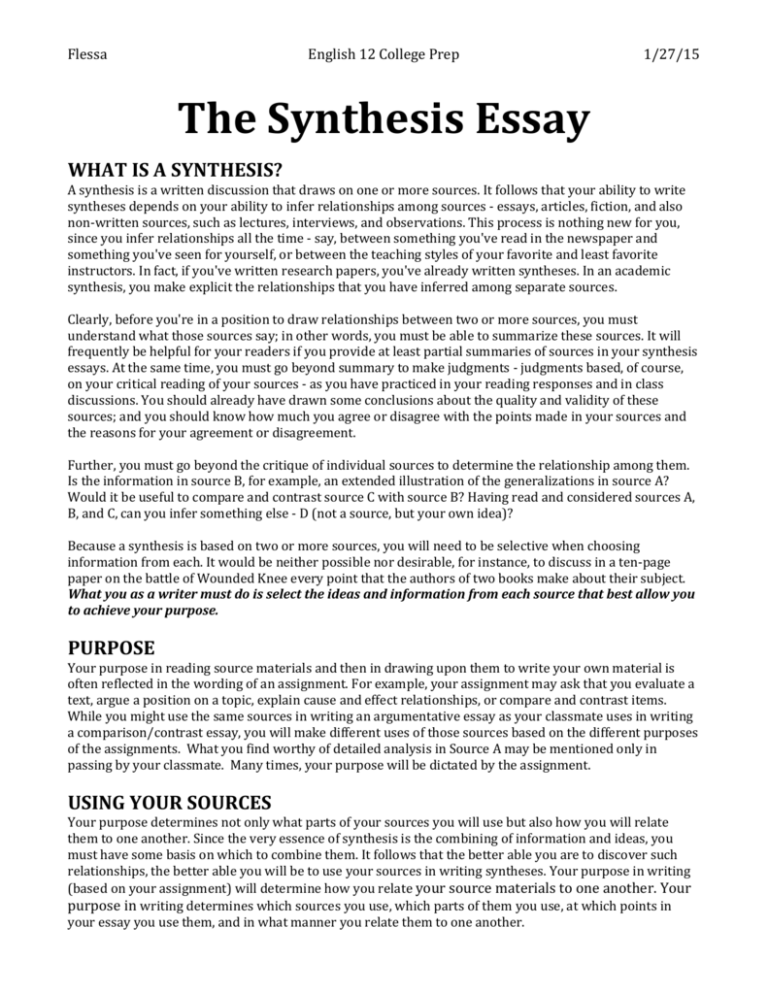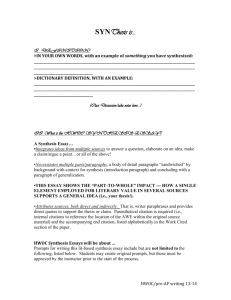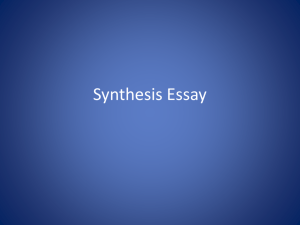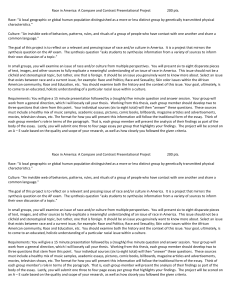How to write a Synthesis Essay
advertisement

Flessa English 12 College Prep 1/27/15 The Synthesis Essay WHAT IS A SYNTHESIS? A synthesis is a written discussion that draws on one or more sources. It follows that your ability to write syntheses depends on your ability to infer relationships among sources - essays, articles, fiction, and also non-written sources, such as lectures, interviews, and observations. This process is nothing new for you, since you infer relationships all the time - say, between something you've read in the newspaper and something you've seen for yourself, or between the teaching styles of your favorite and least favorite instructors. In fact, if you've written research papers, you've already written syntheses. In an academic synthesis, you make explicit the relationships that you have inferred among separate sources. Clearly, before you're in a position to draw relationships between two or more sources, you must understand what those sources say; in other words, you must be able to summarize these sources. It will frequently be helpful for your readers if you provide at least partial summaries of sources in your synthesis essays. At the same time, you must go beyond summary to make judgments - judgments based, of course, on your critical reading of your sources - as you have practiced in your reading responses and in class discussions. You should already have drawn some conclusions about the quality and validity of these sources; and you should know how much you agree or disagree with the points made in your sources and the reasons for your agreement or disagreement. Further, you must go beyond the critique of individual sources to determine the relationship among them. Is the information in source B, for example, an extended illustration of the generalizations in source A? Would it be useful to compare and contrast source C with source B? Having read and considered sources A, B, and C, can you infer something else - D (not a source, but your own idea)? Because a synthesis is based on two or more sources, you will need to be selective when choosing information from each. It would be neither possible nor desirable, for instance, to discuss in a ten-page paper on the battle of Wounded Knee every point that the authors of two books make about their subject. What you as a writer must do is select the ideas and information from each source that best allow you to achieve your purpose. PURPOSE Your purpose in reading source materials and then in drawing upon them to write your own material is often reflected in the wording of an assignment. For example, your assignment may ask that you evaluate a text, argue a position on a topic, explain cause and effect relationships, or compare and contrast items. While you might use the same sources in writing an argumentative essay as your classmate uses in writing a comparison/contrast essay, you will make different uses of those sources based on the different purposes of the assignments. What you find worthy of detailed analysis in Source A may be mentioned only in passing by your classmate. Many times, your purpose will be dictated by the assignment. USING YOUR SOURCES Your purpose determines not only what parts of your sources you will use but also how you will relate them to one another. Since the very essence of synthesis is the combining of information and ideas, you must have some basis on which to combine them. It follows that the better able you are to discover such relationships, the better able you will be to use your sources in writing syntheses. Your purpose in writing (based on your assignment) will determine how you relate your source materials to one another. Your purpose in writing determines which sources you use, which parts of them you use, at which points in your essay you use them, and in what manner you relate them to one another. Flessa English 12 College Prep 1/27/15 TWO TYPES OF SYNTHESES THE EXPLANATORY SYNTHESIS: THE ARGUMENT SYNTHESIS: An explanatory synthesis helps readers to understand a topic. Writers explain when they divide a subject into its component parts and present them to the reader in a clear and orderly fashion. Explanations may entail descriptions that re-create in words some object, place, event, sequence of events, or state of affairs. The purpose in writing an explanatory essay is not to argue a particular point, but rather to present the facts in a reasonably objective manner. The explanatory synthesis does not go much beyond what is obvious from a careful reading of the sources. You will not be writing explanatory synthesis essays in this course. However, at times your argumentative synthesis essays will include sections that are explanatory in nature. The purpose of an argument synthesis is for you to present your own point of view supported, of course, by relevant facts, drawn from sources, and presented in a logical manner. The thesis of an argumentative essay is debatable. It makes a proposition about which reasonable people could disagree, and any two writers working with the same source materials could conceive of and support other, opposite theses. HOW TO WRITE SYNTHESIS ESSAYS 1. Consider your purpose in writing. Read the topic assignment carefully. What are you trying to accomplish in your essay? How will this purpose shape the way you approach your sources? 2. Select and carefully read your sources, according to your purpose. Re-read the sources, mentally summarizing each. Identify those aspects or parts of your sources that will help you in fulfilling your purpose. When rereading, label or underline the passages for main ideas, key terms, and any details you want to use in the synthesis. 3. Formulate a thesis. Your thesis is the main idea that you want to present in your synthesis. It must be expressed as a complete sentence and include a statement of the topic and your assertion about that topic. Sometimes the thesis is the first sentence, but more often it is the final sentence of the first paragraph. 4. Decide how you will use your source material and take notes. How will the information and the ideas in your sources help you to fulfill your purpose? Re-read your sources and write down the information from your sources that will best develop and support your thesis. 5. Develop and organizational plan, according to your thesis. How will you arrange your material? It is not necessary to prepare a formal outline, but you should have some plan in mind that will indicate the order in which you will present your material and that will indicate the relationships among your sources. 6. Write the first draft of your synthesis, following your organizational plan. Be flexible with your plan, however, and allow yourself room to incorporate new ideas you discover as you write. As you discover and incorporate new ideas, re-read your work frequently to ensure that your thesis still accounts for what follows and that what follows still logically supports your thesis. 7. Document your sources. Use MLA-style in-text citations and a Works Cited list to credit your sources for all material you quote, paraphrase, or summarize. For example, if I wanted to note in my essay the difference between name-calling and argumentum ad hominem as personal forms of attack, I would credit the article on "Politics: The Art of Bamboozling" from WARAC by offering a citation that includes the author's last name and the exact page number where she discussed this notion (Cross 302). At the end of the essay, I would have a complete bibliographic citation for the "Politics" article. 8. Revise your synthesis. Insert transitional words and phrases where necessary. Integrate all quotations so they flow smoothly within your own sentences. Use attribution phrases to distinguish between your sources' ideas and your own ideas. Make sure the essay reads smoothly, logically, and clearly from beginning to end. Check for grammatical correctness, punctuation, and spelling. Flessa English 12 College Prep 1/27/15 TECHNIQUES FOR DEVELOPING SYNTHESIS ESSAYS There are a number of different ways in which to organize a synthesis essay. We will be exploring all of them over the course of the marking period. Each technique can be applied to either the explanatory or argument style of synthesis writing. SUMMARY: The simplest - and least sophisticated - way of organizing a synthesis essay is to summarize your most relevant sources, one after the other, but generally with the most important source(s) last. The problem with this approach is that it reveals little or no independent thought on your part. Its main virtue is that it at least grounds your paper in relevant and specific evidence. Summary can be useful - and sophisticated - if handled judiciously, selectively, and in combination with other techniques. At some time you may need to summarize a crucial source in some detail. At another point, you may wish to summarize a key section or paragraph of a source in a single sentence. Try to anticipate what your reader needs to know at any given point of your paper in order to comprehend or appreciate fully the point you are making. EXAMPLE OR ILLUSTRATION: At one or more points in your paper, you may wish to refer to a particularly illuminating example or illustration from your source material. You might paraphrase this example (i.e., recount it, in some detail, in your own words), summarize it, or quote it directly from your source. In all these cases, of course, you would properly credit your source. TWO (OR MORE) REASONS: The "two reasons" approach can be an extremely effective method of development. You simply state your thesis, then offer reasons why the statement is true, supported by evidence from your sources. You can advance as many reasons for the truth of your thesis as needed; but save the most important reason(s) for last, because the end of the paper is what will remain most clearly in the reader's mind. STRAWMAN: When you use the strawman technique, you present an argument against your thesis, but immediately afterward you show that this argument is weak or flawed. The advantage of this technique is that you demonstrate your awareness of the other side of the argument and show that you are prepared to answer it. The strawman argument first presents an introduction and thesis, then the main opposing argument, a refutation of the opposing argument, and finally a positive argument. CONCESSION: Like the strawman, the concession technique presents the opposing viewpoint, but it does not proceed to demolish the opposition. Instead, it concedes that the opposition has a valid point but that, even so, the positive argument is the stronger one. This method is particularly valuable when you know your reader holds the opposing view. COMPARISON AND CONTRAST: Comparison and contrast techniques enable you to examine two subjects (or sources) in terms of one another. When you compare, you consider similarities. When you contrast, you consider differences. By comparing and contrasting, you perform a multifaceted analysis that often suggests subtleties that otherwise might not have come to your attention. To organize a comparison/contrast analysis, you must carefully read sources in order to discover significant criteria for analysis. A criterion is a specific point to which both of your authors refer and about which they may agree or disagree. The best criteria are those that allow you not only to account for obvious similarities and differences between sources but also to plumb deeper, to more subtle and significant similarities and differences. There are two basic formulas for comparison/contrast analysis: Flessa English 12 College Prep 1/27/15 12 TIPS FOR WRITING A SYNTHESIS ESSAY 1. Remember that you are using your sources to support your ideas and claims, not the other way around. 2. Keep in mind that original thought and insightful analysis are required for a 4.0, 3.5, or 3.0 paper; 2.5 and below evaluations tend not to present original ideas. 3. A 4.0, 3.5, or 3.0 paper will create a "dialogue" between the essay author's ideas and her sources, and also among the sources themselves. 2.5 and below evaluations will often summarize one point at a time, with the essay author's idea stated at the end. If you imagine a synthesis essay as a room in which the synthesis writer is joined by the authors of her/his sources, the 4.0, 3.5, or 3.0 essay has everyone engaged in conversation or debate, with everyone commenting on (or arguing against) each other's ideas directly. In the 2.5 and below essay, each person in the room stands up in turn, gives a speech, and sits down, with little or no question and answer period in between or afterward. 4. Take special care to address your audience in an appropriate manner. Make sure you establish your credibility on the subject and that you provide sufficient information to make your argument (thesis) convincing. 5. Organize your paper logically: A. State your thesis clearly and make sure that it reflects the focus of your essay. B. Make sure your main points are clearly stated (use topic sentences), and connect each point to your thesis as explicitly as possible. C. Divide paragraphs logically. D. Provide appropriate transitions both within and between paragraphs. 6. Develop each main idea thoroughly. Use specific examples and source materials appropriately as support. Be sure to integrate source materials smoothly into your own writing using attribution phrases and transitions. Also be sure to avoid unnecessary repetition (repetition is often an organization problem). 7. Select words precisely. When in doubt, use a dictionary! 8. Make sure sentences are clear and unambiguous. Avoid passive voice. Double-check to see that sentences are adequately varied in length and style, and that there are no fragments or run-ons. Also proofread carefully to correct any other sentence errors. 9. Proofread carefully to identify and correct mechanical errors, such as errors in plurals or possessives, subject-verb agreement, shifts in verb tense or person ("you"), comma errors, spelling errors, and so on. 10. Quadruple check your MLA documentation. Are your parenthetical citations correct? Is your Works Cited list correct according to MLA style, and does it include all sources cited in your essay? 11. Be sure to give your essay a descriptive and attention-getting title (NOT "Synthesis," for goodness sake!!!). 12. Make sure your essay is formatted correctly.





